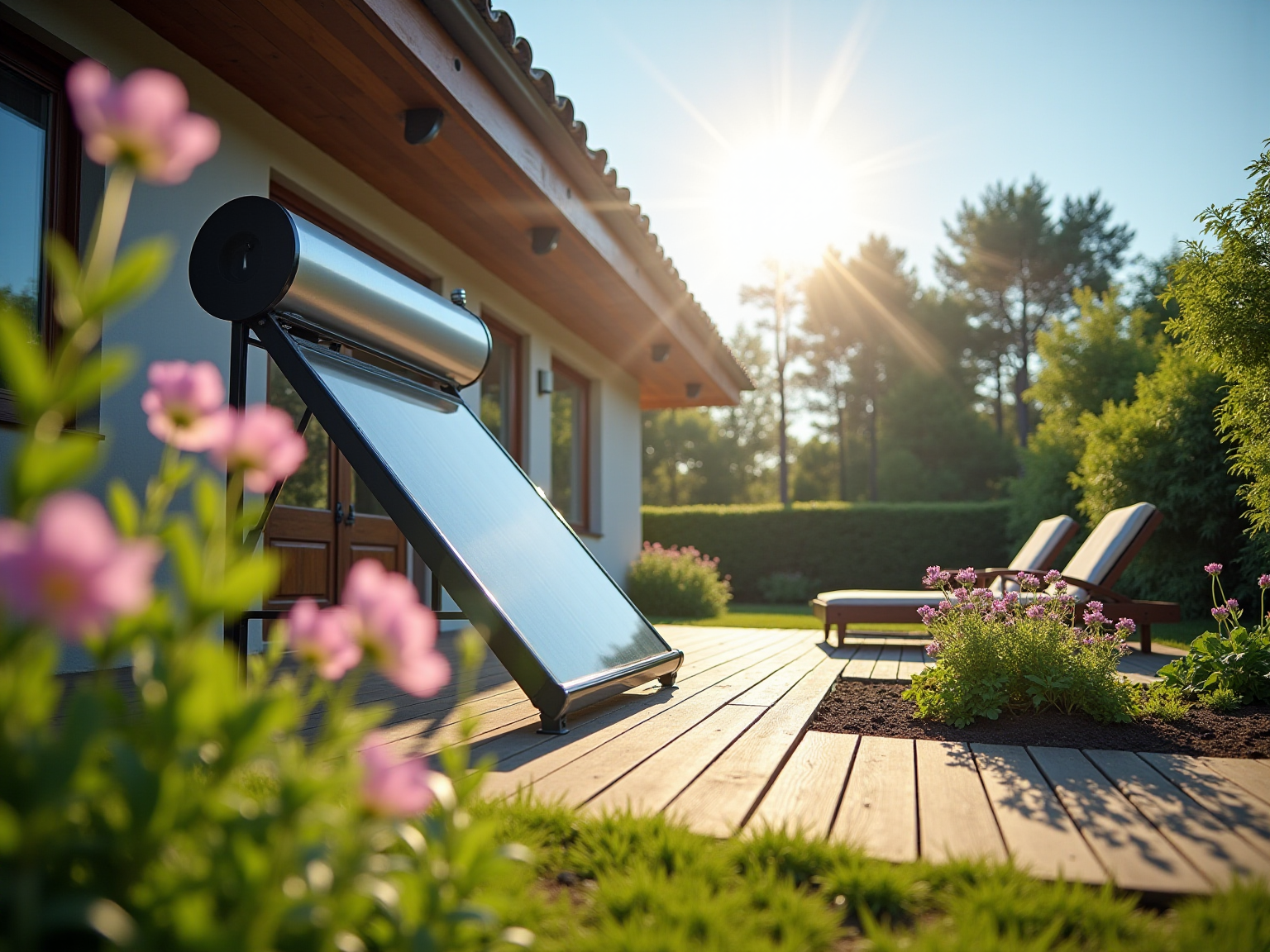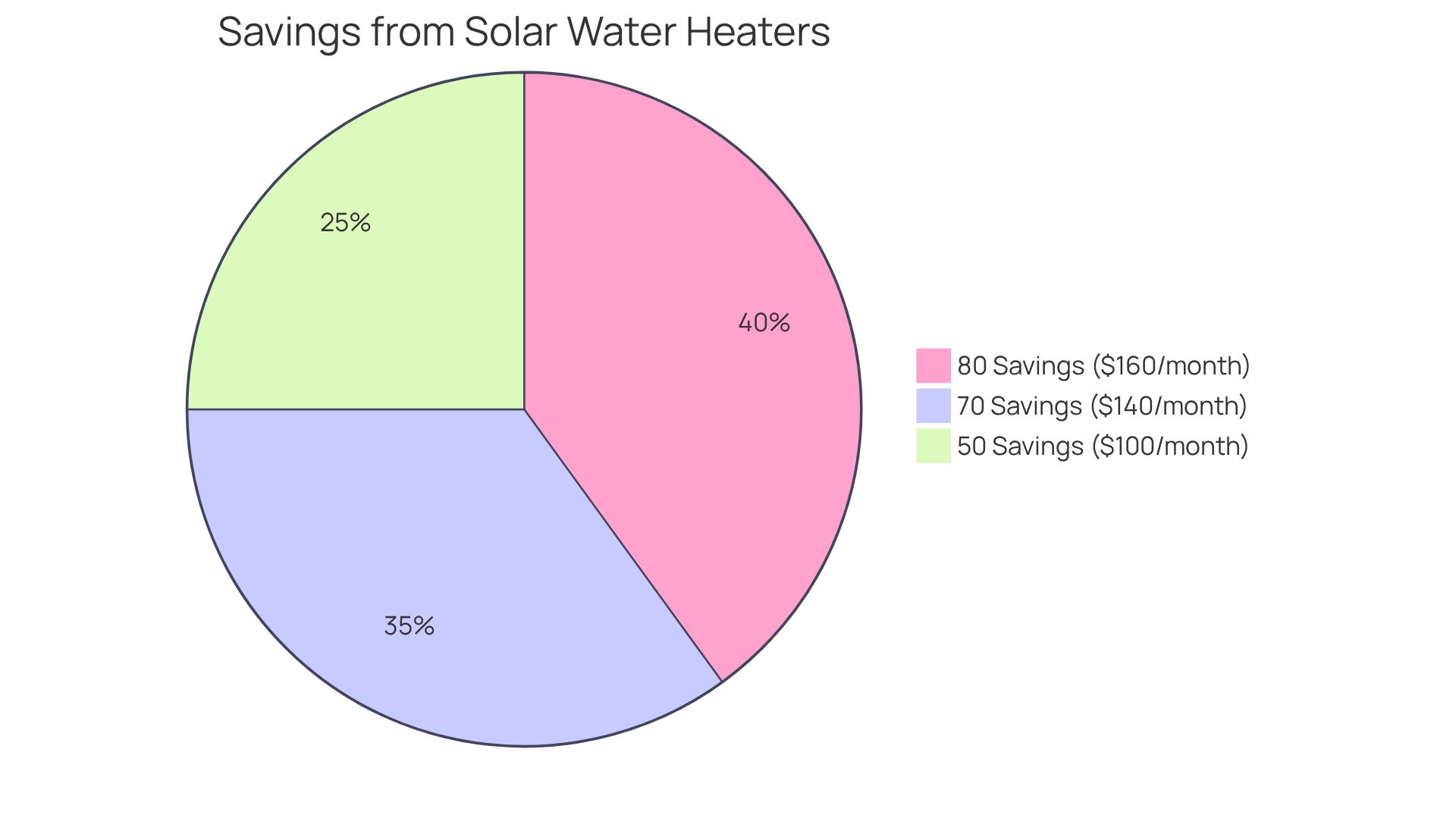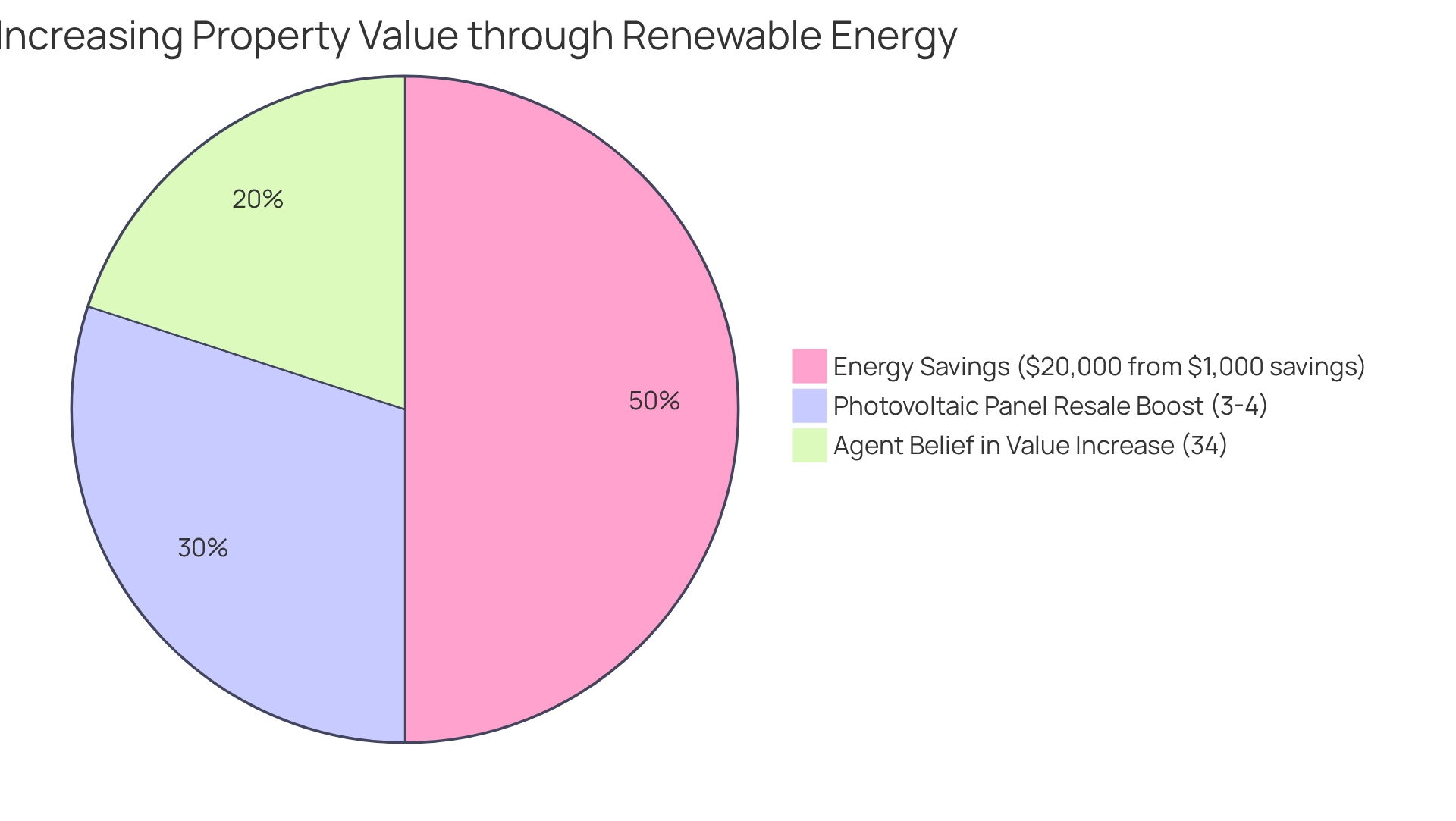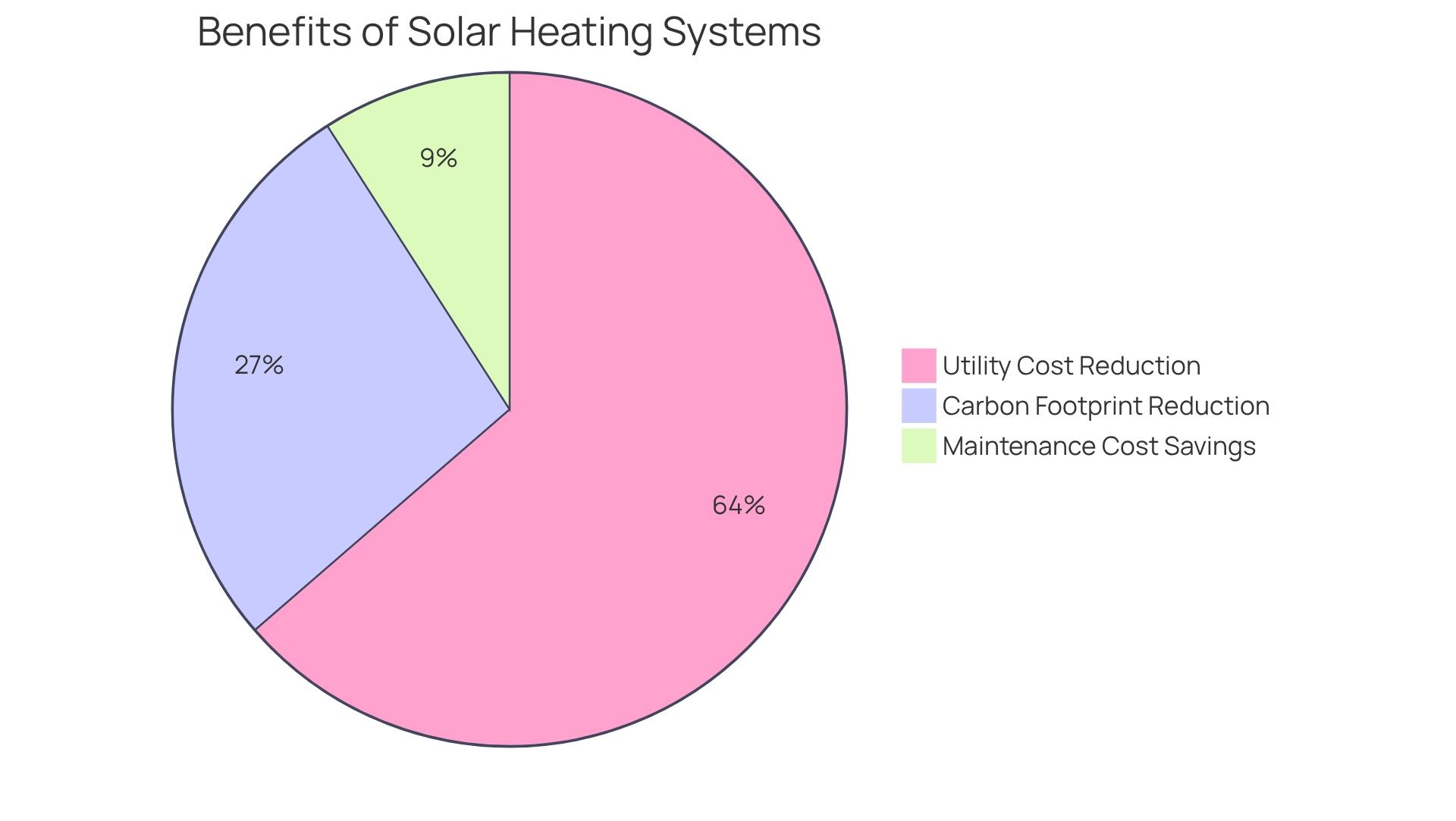Overview
Are you feeling overwhelmed by rising energy bills? You’re not alone. Many eco-conscious homeowners share your concerns, and there’s a solution that can not only alleviate your financial worries but also contribute to a healthier planet. Solar hot water heaters offer remarkable benefits that can transform your home and your lifestyle.
By embracing solar thermal systems, you can significantly reduce your energy expenses—potentially by up to 80%. Imagine the relief of seeing those bills shrink while knowing that you’re making a positive impact on the environment by minimizing greenhouse gas emissions. Beyond the immediate savings, these systems can also enhance your property’s market value, supported by data that shows a strong return on investment.
We understand that investing in your home can feel daunting, but with available government incentives, taking this step toward energy independence becomes more accessible. Together, we can work towards a sustainable future that benefits not just you, but the community and the planet as well. Let’s explore how solar hot water heaters can be a part of your journey to a greener, more cost-effective lifestyle. Your home deserves it, and so do you.
Introduction
In a time when the concerns of rising energy bills weigh heavily on many homeowners, solar water heaters present a nurturing solution for those looking to ease their financial burden and embrace sustainability. By harnessing the sun’s energy, these innovative systems can significantly reduce water heating costs by 50% to 80%, offering substantial annual savings that can bring peace of mind.
Beyond the financial relief, they play a vital role in fostering a greener future, emitting far fewer greenhouse gases than traditional heating methods. As more homeowners prioritize eco-friendly choices, it becomes essential to understand the many benefits of solar water heaters—from long-term savings to increased property value.
Together, we can explore the transformative impact of solar water heating technology, focusing on its efficiency, reliability, and the promising incentives available for those ready to make this empowering switch.
We understand that taking the first step towards energy independence can feel daunting, but rest assured, there is support and guidance available to help you navigate this journey.
Lower Energy Bills with Solar Water Heaters
Are you feeling overwhelmed by rising heating expenses? You’re not alone. Solar thermal systems can significantly alleviate this burden, often reducing costs by 50% to 80%. By harnessing the power of sunlight, homeowners can access nearly free heated liquid, leading to substantial long-term savings. For example, imagine a home that typically spends $200 each month on heating; with a thermal system in place, that cost could plummet to as little as $40, translating to yearly savings of up to $1,920.
The financial advantages of these systems are further underscored by numerous case studies, which reveal that homeowners often recoup their investments within three to six years, thanks to considerable utility savings and potential tax benefits. A system priced at $4,000, for instance, becomes more affordable at $2,800 after a 30% federal tax rebate, making this investment even more appealing. As we look toward 2025, the benefits of thermal systems extend beyond mere cost savings; they also promote efficiency and sustainability, making them a wise choice for conscientious homeowners. Recent findings indicate that installing hot water heater solar systems can drastically lower utility bills, providing a compelling reason for eco-conscious individuals to explore this technology.
Many case studies highlight the effectiveness of thermal heating solutions across various climates. For instance, a home in Southern California experienced over a 70% reduction in utility costs after installing a solar-powered heating system. This remarkable outcome showcases the significant savings and sustainability benefits available. In cooler regions, passive power collection designs have proven successful, with homes utilizing large south-facing windows to capture sunlight during winter, further decreasing expenses. Local companies, as noted by industry expert Andy Sendy, offer installation of both panel systems and hot water heater solar units, providing tailored solutions for homeowners. This ensures that you can maximize your resource savings while embracing sustainable practices. Additionally, understanding the distinction between direct active systems, which are best suited for warmer climates, and indirect systems, which perform reliably in cooler areas, can help you choose the right system for your needs.
To optimize your investment in heating systems, consider reaching out to local experts who can assess your specific requirements and explore available incentives. Together, we can work towards a more sustainable and cost-effective future.
Reduce Your Carbon Footprint
We understand that rising energy bills can be a significant concern for homeowners. Utilizing sunlight energy not only alleviates this burden but also empowers you to lessen your reliance on fossil fuels, leading to a remarkable reduction in your carbon footprint.
Solar thermal systems shine in this regard, generating minimal greenhouse gas emissions compared to traditional heating systems. On average, a standard heating system can prevent approximately 1,500 pounds of CO2 emissions annually. It’s common to feel overwhelmed by these numbers, but consider this: according to Sam Wigness, “the carbon footprint of rooftop photovoltaic panels is roughly 12 times less than natural gas and 20 times less than coal, in terms of CO2 emissions per kWh of electricity generated.”
This reduction not only fosters a healthier environment but also plays a crucial role in the fight against climate change. By embracing hot water heater solar solutions, you contribute to a sustainable future while enjoying the benefits of lower utility expenses and enhanced power independence. Together, we can make a difference.
Ryan, a satisfied customer, shared, “I have referred Powercore to some friends and they were also happy with their service.” Local companies like Powercore Electric, which has proudly served California for over 30 years, exemplify a strong community focus and commitment to exceptional service. Their dedication to customer-first service ensures that you receive the support you need in your transition to sustainable power practices, making the adoption of eco-friendly technologies more attainable and efficient.
Let’s work towards a brighter, cleaner future together.
Long-Term Financial Savings
Are you feeling overwhelmed by rising energy bills? Investing in a thermal heater can bring you considerable long-term savings, providing not just relief but also peace of mind. While the initial installation cost typically ranges from $3,000 to $7,000, this investment can be recouped through lower utility bills and available tax credits. Over the lifespan of the system, which can exceed 20 years, total savings may reach $20,000 or more, making this a financially wise choice for your home.
For instance, a heartening case study from Southern California revealed a household that achieved an impressive reduction in energy costs, exceeding 70%, after installing a thermal heating system. This setup not only led to significant savings but also supported their sustainability efforts by reducing their carbon footprint. In contrast, a study on the operating costs of a conventional electric unit in Hawaii showed annual expenses of around $1,684. This comparison underscores the economic benefits of transitioning to a renewable energy system, as homeowners could save over $1,500 each year, greatly improving their financial situation.
Moreover, the internal rate of return (IRR) for thermal heating systems over 20 years ranges between 13.44% and 17%, showcasing their viability as a long-term investment. As we all strive to minimize our carbon footprints, thermal heaters present not only financial advantages but also contribute to sustainable living practices. With property owners increasingly seeking autonomy and economical solutions, the benefits of solar energy systems become even more compelling.
Additionally, initiatives like the Rural Energy for America Program (REAP) support investments in renewable resources, emphasizing the importance of transitioning to sustainable power solutions. Together, we can embrace these changes and work towards a more sustainable future. If you’re ready to explore how thermal heating can benefit your home, let’s connect and discuss the options available to you.
Reliable Energy Source During Outages
In today’s world, many homeowners are understandably concerned about the reliability of their energy sources, especially with the increasing frequency of power outages. Thermal systems offer a dependable supply of heated liquid, even during these challenging times. By harnessing the power of sunlight, these systems ensure operation while daylight is present, providing a comforting solution for property owners in California, where power failures have become more common. Reports indicate that the state faces thousands of power interruptions each year, impacting daily life and essential needs.
During outages, thermal systems continue to operate efficiently, ensuring access to heated liquid for cooking, sanitation, and other vital tasks. Unlike electric on-demand systems, which lack a reserve of heated fluid and can leave homeowners without hot water during extended outages, photovoltaic systems can deliver a continuous supply as long as the sun shines. We understand that this reliability is crucial for maintaining comfort and hygiene in your home.
However, it’s important to consider that electric pumps in photovoltaic systems may not function without power. Homeowners should check for manual overrides to ensure their systems remain operational during outages. Case studies illustrate the resilience of thermal systems; for example, indirect systems can utilize a home’s space heating arrangement to warm liquid, remaining functional if the main heating setup operates independently of electricity. This means that even when the grid fails, homeowners can still enjoy heated liquid, enhancing their energy autonomy.
Expert insights highlight the reliability of solar-powered systems during outages, emphasizing their role in promoting sustainable living while safeguarding against power interruptions. As noted by Magnificent Plumbing, most gas heaters do not require electricity to operate, contrasting with solar heating devices that may depend on power for certain components. By investing in renewable heating solutions, such as a hot water heater solar, eco-conscious homeowners can prepare for unexpected power outages, ensuring comfort and hygiene without solely relying on the electrical grid.
Furthermore, integrating photovoltaic battery systems can significantly enhance energy storage capabilities, allowing homeowners to maximize their renewable energy use and further reduce dependence on the grid. Together, we can work towards the broader goal of energy independence, creating a more sustainable future for ourselves and our communities. Let’s take the first step towards this empowering journey, ensuring that your home remains a sanctuary of warmth and comfort, no matter the circumstances.
Minimal Maintenance Needs
Are you feeling overwhelmed by rising energy bills? One of the most compelling benefits of thermal systems is their low upkeep needs, which can offer you peace of mind. Generally, these systems require only periodic evaluations every three to five years and occasional cleaning of the panels to ensure optimal performance. Unlike conventional heating systems that frequently demand repairs or replacements, renewable heating systems boast an impressive lifespan of approximately 20 years, functioning effectively with minimal intervention. This longevity can lead to substantial savings, with possible decreases in costs ranging from 50% to 80%.
Consider the experience of a residence in Southern California, which saw more than a 70% reduction in energy costs after installing a heating system that utilizes renewable resources along with a heat exchanger. This setup not only provided substantial savings but also contributed to their sustainability efforts by reducing their carbon footprint. Active thermal heating systems, which employ circulating pumps, are the most prevalent option for both commercial and residential uses due to their efficiency. While they may incur slightly higher initial costs, their efficiency and reliability make them a worthwhile investment. In contrast, passive systems, which rely on gravity and thermosiphon properties, are less effective and not recommended for colder climates.
We understand that maintenance costs are a concern for many homeowners. Maintenance expenses for photovoltaic thermal systems are typically minimal, averaging between 0.5% and 2% of the original system expense annually, based on the technology and design intricacy. As noted by mechanical engineer Andrea Mott, “All types of SWH systems require very little maintenance, and O&M costs are generally between 0.5% and 2% of the initial cost per year, depending on the technology type and complexity of the design.” This is considerably less than the ongoing expenses linked to conventional systems, which frequently necessitate more regular maintenance.
Overall, the blend of durability, effectiveness, and minimal upkeep makes solar-powered systems an appealing choice for homeowners like you who are aiming to adopt renewable energy options. Together, we can optimize the advantages of thermal systems by considering specific product choices and setup recommendations that match your home’s requirements. Let’s work towards a more sustainable and cost-effective energy future.
Increase Your Property Value
Are you feeling overwhelmed by rising energy bills? Installing a solar-powered hot water heater can not only alleviate those concerns but also significantly enhance your property’s value. Homes equipped with renewable energy technology are increasingly seen as more appealing, often leading to higher resale values. Research reveals that for every dollar saved on energy bills, a home’s value can increase by approximately $20. Imagine a water heater that saves you $1,000 each year—this could potentially elevate your home’s market value by around $20,000.
Moreover, studies show that photovoltaic panels can boost the resale value of a typical residence by approximately 3% to 4%. This broader perspective on the financial advantages of such installations is encouraging. Real estate specialists, like Ana Almerini, Marketing & Communications Manager at SolarReviews, support this trend. In a 2023 report, she noted that 34% of agents believed renewable energy could enhance home values in their markets.
As electricity costs continue to rise, the appeal of renewable energy options, such as solar hot water heater systems, is expected to grow. This positions them as a wise investment for homeowners like you, who are looking to enhance their property value. At Powercore Electric Inc., we have over 30 years of experience in the renewable energy sector, underscoring the importance of these sustainable choices. Our commitment to exceptional service and local expertise ensures that you can trust the financial benefits of your energy installations.
Our satisfied customers often share their positive experiences, with one client stating, “Ryan and his team were great. They were quick, effective, and adhered to the timeline for our energy installation.” This level of service distinguishes Powercore from competitors, making us a top choice for homeowners in California. Together, let’s explore how we can support your journey towards energy independence and a more sustainable future.
Access to Government Incentives
We understand that homeowners often feel the weight of rising energy bills, and it can be overwhelming to consider the costs of installing heating systems. However, there are ways to significantly lessen this financial strain through various government incentives. Currently, federal tax credits cover up to 30% of installation expenses, making thermal heating a more attainable investment for many families.
In addition to federal support, numerous states and local governments offer rebates and incentives that can further decrease overall expenses. For instance, the Residential Clean Energy tax credit provides guidance on how to claim these benefits, as outlined in Publication 5977, ensuring you can maximize your savings.
As Kunz wisely notes, “Every program and credit are based on different homeowners’ needs, so it’s important to do your homework to find the incentive that best fits your needs to see if you qualify.” Real-world instances show that many homeowners have effectively used these credits to reduce installation expenses, increasing the attractiveness of hot water heater solar systems.
Looking ahead to 2025, these incentives continue to evolve, offering a strong framework for eco-conscious homeowners to shift to sustainable power solutions while enjoying significant financial advantages. Additionally, Powercore Electric’s in-house team of experts ensures high-quality installations, further reassuring you about your investment.
Moreover, exploring alternatives such as Tesla home chargers and photovoltaic panel systems can enhance these incentives, providing extra savings and efficiency in power usage. Together, let’s work towards a more sustainable and financially sound future.
Compatibility with Existing Systems
We understand that rising energy bills can be a significant concern for homeowners. Solar thermal systems offer a wonderful opportunity to transition to renewable resources without the need for extensive renovations. These systems can easily connect with your existing electric or gas appliances, allowing you to keep your current setup while reaping the benefits of renewable energy. This flexibility not only makes the transition smoother but also enhances overall efficiency and cost-effectiveness.
Imagine the relief of reducing your energy costs significantly. Numerous case studies demonstrate the effectiveness of sunlight-powered heaters in various residential settings. For instance, a home in Southern California experienced over 70% reductions in energy costs after installing a thermal heating system paired with a heat exchanger. This setup not only provided substantial savings but also supported sustainability efforts by lowering their carbon footprint.
You might be surprised to learn that the cost of evacuated tube collectors for larger systems can be as affordable as $40 to $70 per square foot, making renewable energy solutions more accessible than ever. We encourage you to explore governmental programs for photovoltaic panels that can provide financial benefits and assistance in integrating thermal systems into your home.
Together, we can optimize your heating systems. By utilizing hourly simulation software, you can obtain precise engineering data and conduct economic analyses to ensure the best possible integration with your current setup. Consulting with professionals can further enhance the effectiveness of this transition, guiding you every step of the way. Let’s work towards a more sustainable future together.
Advanced Technology and Efficiency
We understand that rising energy bills can be a significant concern for homeowners. Contemporary water heaters, equipped with cutting-edge technology, offer a solution that not only improves efficiency but also brings peace of mind. With high-efficiency energy collectors and superior insulation, these systems can achieve efficiency ratings exceeding 90%. This exceptional performance means that a substantial amount of sunlight is transformed into usable heat, maximizing your return on investment. Moreover, the incorporation of intelligent technology allows for enhanced monitoring and optimization of power usage, empowering you to control your system more effectively.
As we explore recent advancements in sunlight-powered heating technology, it’s heartening to see the emergence of hot water heater solar models that not only lower utility expenses but also promote environmental sustainability. For instance, parabolic dish reflector collectors have emerged as the leading performers among solar collectors, demonstrating remarkable capabilities for energy capture and use.
When considering the optimal hot water heater solar appliance, it’s essential to evaluate your regional climate conditions, household hot liquid requirements, budget factors, and the simplicity of installation and upkeep. Understanding the First Hour Rating (FHR) is crucial, as it assesses the quantity of heated liquid a device can provide in the initial hour of operation—especially significant for homes with high demand. Case studies have shown various approaches to enhance heater efficiency, such as adequate insulation, thermostat modifications, and routine upkeep. For example, a family in Southern California experienced an impressive reduction in energy costs of over 70% after installing a thermal heating system, highlighting the substantial savings and ecological benefits associated with these technologies.
By adopting these methods, you can look forward to decreased utility charges and enhanced efficiency of your heating systems. As technology continues to advance, we can anticipate even greater efficiency and reliability from our heating solutions. Furthermore, understanding the payback durations for different system models can assist you in evaluating the financial feasibility of your investment in heating technology. This knowledge is vital for eco-conscious homeowners like you, who are eager to make sustainable choices. Together, let’s work towards a more energy-independent future.
Eco-Friendly Heating Solution
We understand that rising energy bills can be a significant concern for many homeowners. Solar heating systems offer a sustainable solution that not only reduces reliance on fossil fuels but also alleviates some of that financial burden. By harnessing the power of sunlight, these systems cut down on greenhouse gas emissions, promoting a lifestyle that is kinder to our planet.
When households transition to renewable heating, they can see a substantial decrease in their carbon footprint, contributing positively to environmental sustainability. For instance, a home in Southern California experienced over a 70% reduction in utility costs after installing a thermal heating system. This not only highlights the financial advantages of this technology but also demonstrates how it can be a wise investment for the future.
As energy expenses continue to rise, the appeal of thermal technology grows, allowing homeowners to enjoy efficient heating while making a meaningful impact on the environment. This transition fosters a sense of autonomy in energy use and aligns with our collective efforts to combat climate change.
Moreover, when we consider the long-term analysis of 25 years regarding maintenance costs and salvage value, solar water heating systems emerge as a cost-effective solution for eco-conscious homeowners. They have the potential to lower monthly energy expenses by 30% and reduce carbon output by 20 to 40 percent.
Together, we can embrace this change and work towards a sustainable future.
Conclusion
We understand that rising energy bills can be a significant concern for homeowners. Investing in solar water heaters offers a remarkable opportunity to alleviate this burden while also contributing to a more sustainable future. With the potential to reduce water heating bills by 50% to 80%, these systems not only ease the strain of increasing energy costs but also promise long-term savings that can exceed $20,000 over their lifespan. Coupled with available tax incentives, the affordability of solar water heaters becomes even more appealing, making this a wise choice for those who are conscious of their energy consumption.
Beyond the economic advantages, the environmental impact of solar water heaters is truly significant. By harnessing renewable solar energy, homeowners can greatly reduce their carbon footprint, preventing an average of 1,500 pounds of CO2 emissions each year. This transition to cleaner energy sources aligns with our collective efforts to combat climate change and fosters a healthier planet for generations to come.
Additionally, the reliability of solar water heaters during power outages enhances their attractiveness. Homeowners can enjoy uninterrupted access to hot water, ensuring comfort and hygiene even when the grid fails. With minimal maintenance requirements and impressive longevity, these systems demand far less attention than traditional water heaters, allowing homeowners to focus on reaping the rewards of their investment.
As the demand for eco-friendly technologies continues to rise, solar water heaters not only boost property value but also demonstrate a commitment to sustainability. By integrating these systems with existing setups and leveraging advanced technology, homeowners can optimize their energy consumption and lessen their reliance on fossil fuels. Embracing solar water heating is more than just a financial decision; it’s a step toward energy independence and a sustainable lifestyle, benefiting both individuals and the environment. Together, let’s work towards a brighter, more sustainable future.






